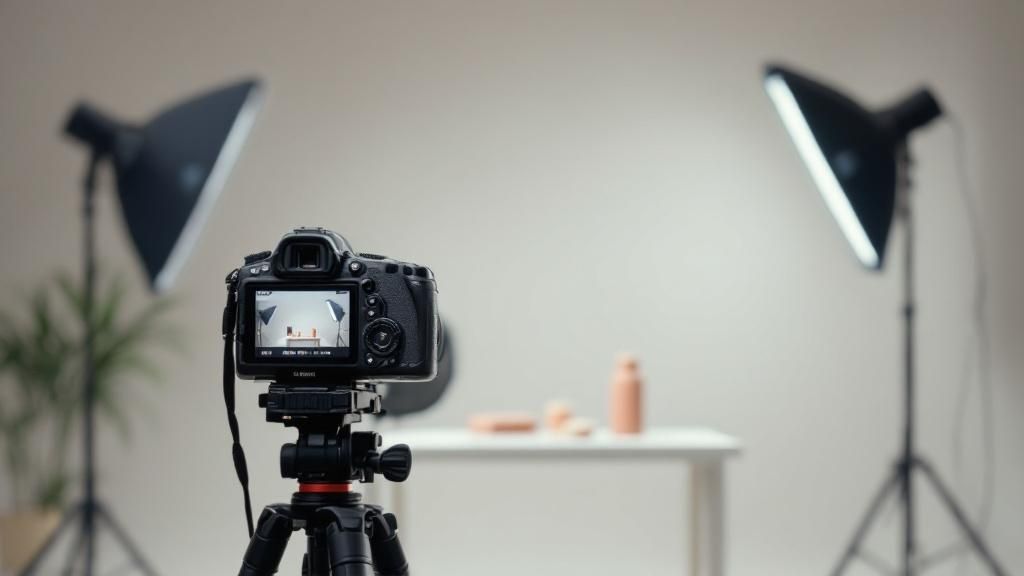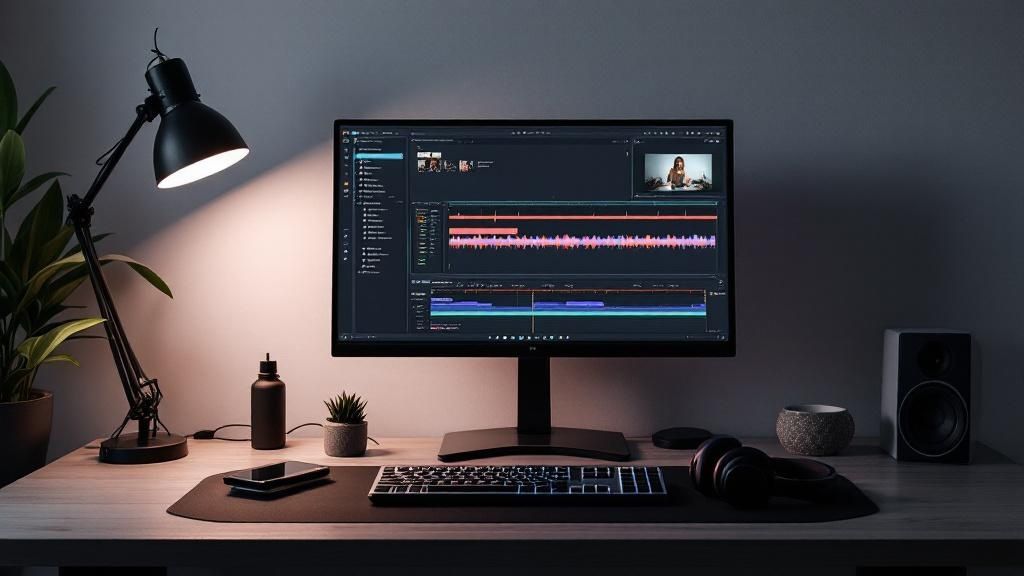AI-Powered Vertical Video Creation: A Guide for Small Businesses
Discover how video production for small business can drive growth. Our guide covers strategy, scripting, and AI tools for creating videos that convert.
FlowVid Team
Discover how video production for small business can drive growth. Our guide covers strategy, scripting, and AI tools for creating videos that convert.
FlowVid Team

Tired of your social media videos getting lost in the noise? You're not alone. The key to growth on platforms like TikTok and Instagram isn't just posting more content—it's creating high-impact vertical videos that stop the scroll, and doing it without a Hollywood budget.
Let's get straight to the point. If vertical video isn't a huge part of your marketing strategy, you're leaving money on the table and letting potential customers scroll right past you. It's time to move beyond the old "video is important" cliché and look at the real, tangible impact a solid YouTube Shorts strategy has on your business.
This isn't about making a slick, expensive commercial. It's about showing up where your audience already is—binging TikToks, swiping through Instagram Reels, and watching YouTube Shorts. These platforms have completely changed the game for how people discover new brands and decide what to buy.
Think about how you discover things today. You're looking for answers and solutions, and more often than not, you're turning to video to find them.
The data backs this up. A staggering 89% of businesses are already using video as a key marketing tool. And about 95% of video marketers plan to maintain or increase their spending on video. You can dive deeper into these video marketing trends to see how your competitors are getting ahead.
Your goal is to stop seeing video as a chore and start seeing it as your most powerful tool for building a community and driving sales. With today's AI tools, it's never been easier.
Before we go further, let's look at some hard numbers that show why video is a game-changer for businesses like yours.
This table breaks down some of the most critical stats showing the direct impact video can have on your bottom line and brand growth.
| Statistic | Impact on Small Business |
|---|---|
| 87% of marketers report video gives them a positive ROI. | Video isn’t just about likes; it directly contributes to revenue and business goals. |
| Landing pages with video can increase conversion rates by over 80%. | A simple product video can be the deciding factor that turns a visitor into a customer. |
| Viewers retain 95% of a message when they watch it in a video. | Your message sticks, leading to better brand recall and customer understanding. |
| Social video generates 1200% more shares than text and images combined. | Video is your best bet for organic reach and getting your brand in front of new audiences. |
These figures aren't just abstract numbers; they represent real opportunities for sales, engagement, and building a loyal customer base.
The days when you needed a professional film crew and a massive budget are long gone. The barrier to entry for creating high-quality video has completely crumbled.
Seriously, that smartphone in your pocket is a 4K camera. Pair it with affordable lighting and a simple microphone, and you can achieve a professional look for next to nothing.
Even better, the editing process—which used to be the biggest headache—is now incredibly simple thanks to AI video generation. Tools like FlowVid handle the heavy lifting like editing, adding captions, and repurposing your videos for different platforms. What used to take days can now be done in minutes, freeing you up to focus on your story and customers.

Hitting record without a plan is a recipe for wasted time and effort. You might get some clips, but you won't get results.
A solid strategy turns random videos into powerful business assets. It ensures every second of footage serves a purpose. This process boils down to one simple question: What do you want your videos to do for your business?
Before you think about cameras or scripts, you have to get crystal clear on what a "win" looks like for you. Are you trying to get more eyeballs on your brand, generate qualified leads, or help customers get more value out of your product?
Each of these goals demands a totally different kind of video.
Nailing down your goals from the start keeps you focused. For a deeper look, our guide on content marketing best practices is a great place to start.
Once you know your "why," you have to figure out your "who." Who is your ideal customer? What problems keep them up at night that you can solve?
Don't just guess. Dig into your customer data and read social media comments. Taking a few minutes to sketch out a simple "viewer persona" can be a game-changer.
A great video doesn't just talk at your audience; it speaks with them. When you genuinely understand their struggles, you can create content that feels personal, helpful, and impossible to ignore.
This insight fuels great video ideas. Instead of asking, "What video can I make?" you'll start asking, "What video would solve a huge problem for my ideal customer?"
Now for the fun part: brainstorming. With your goals and audience defined, you can start building a pipeline of video ideas. Don't hold back—write down everything that pops into your head.
Here’s a little framework to get the ideas flowing:
| Content Pillar | Video Idea Example | Target Platform | Goal |
|---|---|---|---|
| Educate | "Three common mistakes to avoid when [solving a problem]" | TikTok / Reels | Brand Awareness |
| Inspire | "A behind-the-scenes look at how we make our product" | Instagram Reels | Build Trust |
| Entertain | "Jumping on a funny industry-related trend" | TikTok / Shorts | Increase Reach |
| Convert | "A quick demo showing a key feature of our service" | YouTube / Website | Generate Leads |
Try to come up with a backlog of at least 10-15 solid ideas. This pipeline is your secret weapon against inconsistency. It means you're never scrambling for what to post, which is how you win with video.
Let's be real: a great video almost never happens by accident. It starts with a solid script—even a few bullet points on a notepad can be the roadmap you need.
In the blink-and-you'll-miss-it world of vertical video, you have maybe two seconds to stop someone's thumb from scrolling. A well-structured video feels effortless and keeps people watching. Winging it is a recipe for rambling and losing your audience.
You’ve got about three seconds to convince someone your video is worth their time. This is your hook, and it’s the most important part of your script. It needs to be bold, ask a burning question, or hit on a pain point.
Here are a few hook formulas that work like a charm for short-form video:
The whole point is to spark instant curiosity. Getting this right is a cornerstone of effective social media video creation and sets the stage for everything that follows.
Okay, you've got their attention. Now you have to deliver on the promise you made in the hook. The middle of your video is where you drop the knowledge.
Just keep it tight and to the point. The attention span for a 9:16 video format is short, so every second has to count. Break your main idea into two or three simple, easy-to-digest steps.
The best vertical videos are mini-masterclasses. They teach something new, solve a nagging problem, or offer a fresh take—all in under a minute. This is all about serving your audience.
A pro tip for this section: use on-screen text or captions to hammer home your key points. It reinforces your message and makes the video easier to follow, especially since up to 85% of people watch with the sound off.
So you've hooked them in and given them some real value. Now what? Don't just end the video! The final piece of your script has to be a clear, simple call to action (CTA).
A good CTA is direct and low-effort.
This last step transforms a passive viewer into an engaged part of your community. It pulls them deeper into your orbit and turns your video into a hardworking piece of your marketing funnel.
Let's bust a myth: creating high-quality video for your small business doesn't require a Hollywood-sized bank account anymore. Getting a polished, professional result is completely within reach.
Forget complex cameras. The supercomputer in your pocket—your smartphone—is more than capable of shooting incredible, high-resolution video. The real secret isn't the camera; it's knowing a few tricks to make it shine.
Your phone is the best budget-friendly filmmaking tool you can ask for. Modern smartphones shoot in stunning 4K and have amazing built-in stabilization.
First, always lock your focus and exposure before you record. Just tap and hold on your subject on the screen. This stops the camera from "breathing"—that distracting auto-adjusting it does—and keeps your shot looking clean.
Also, shoot at a higher frame rate like 60 frames per second (fps) if you can. This makes motion look incredibly smooth and gives you the option to create silky slow-motion clips when editing.
If you want to spot an amateur video, look for bad lighting and listen for poor audio. The good news? Both are easy to fix on a shoestring budget.
Now, let's talk about sound. People will forgive a slightly shaky video, but they will not stick around for bad audio. Your phone's mic picks up everything around you.
A simple lavalier microphone that clips onto your shirt can cost as little as $20. This is arguably the single most impactful, low-cost investment you can make in your video production setup.
When creating videos for TikTok, Instagram Reels, or YouTube Shorts, you have to think vertically. The 9:16 video format is a whole different ballgame, and understanding how to use that canvas is key.
Framing is everything. You need to think tall. Keep your main subject centered and use the vertical space to your advantage. This ensures your most important visuals aren't awkwardly cropped by the app's interface.
This infographic gives you a great overview of the creative workflow, from that first spark of an idea to the final product.
Following a process like this means that by the time you're ready to start shooting, your vision is crystal clear. This structured approach is how you can create great content again and again.

Okay, you've got your footage. Now for the edit—the part where raw clips turn into a real story. For many creators, this is where a great idea grinds to a halt.
The old way meant painstakingly trimming clips and fiddling with graphics. But that’s changing. Smart automation with AI video generation is giving small businesses and creators a serious edge.
Editing isn't just about slicing clips anymore, especially for vertical video. To grab attention, you need dynamic captions, snappy transitions, and the right music.
AI tools are flipping the script. We've seen a huge jump in their use for video production, from just 18% in 2023 to 41% in 2024. This is a real shift in how we create content. You can dive deeper into these video marketing statistics to see how much the game is changing.
AI isn’t here to replace your creativity. It’s here to handle the repetitive tasks so you can focus on your story, your message, and connecting with your audience.
By letting AI handle the technical grind, you get to keep your creative energy for what really matters.
So, what does this look like in the real world? Let’s say you have a 10-minute video. Instead of blocking out a full day for editing, an AI-powered platform like FlowVid can do the heavy lifting.
Here's how AI video generation gives you editing superpowers:

The image above shows the clean interface in FlowVid. You just upload your content, and the AI takes over. It’s all about turning one piece of content into an entire social media campaign with a few clicks.
Let's walk through a common scenario. You just filmed a 5-minute "how-to" video. The goal is a main video for YouTube plus five separate clips for Instagram Reels.
Instead of the old, tedious process, here's the new way:
First, you upload your raw 5-minute video file into FlowVid. Simple enough.
Next, the platform’s AI gets to work. It transcribes the audio and automatically pinpoints the most punchy soundbites and interesting visual moments.
Then, FlowVid suggests a bunch of potential vertical clips. No more endless scrubbing through the timeline. The clips even come with catchy headlines and slick animated captions already applied.
Finally, you just pick the five clips you like best. You can make small tweaks, then export them directly in the 9:16 video format. What used to be an entire afternoon of work is now done in less than 15 minutes.

Creating an incredible video is a huge win, but that’s only half the battle. Getting it in front of the right eyeballs is how you turn creative effort into business results.
This isn’t about just hitting "publish" and crossing your fingers. It's about being strategic with your platforms, captions, and timing to give your content the best possible shot at taking off.
It's tempting to just post the same video everywhere, but a little platform-specific tweaking goes a long way. Each social network has its own vibe and audience expectations.
Tailoring your approach shows you get the culture of each platform. If you're looking for more ways to grow, we've got a whole guide on effective social media growth strategies.
The magic happens when the content feels like it was made for the platform it’s on. Don't just post your video; adapt it to speak the language of each audience.
The data backs this up. An impressive 93% of marketers say video marketing gives them a good return on investment (ROI). You can dig into the numbers in this breakdown of video marketing ROI.
The final piece of the puzzle is analyzing what happened. Dive into your analytics to see which videos are hitting the mark. This data is your roadmap for what to create next.
Jumping into video for the first time can feel overwhelming. You've got questions, and that's a great sign. Let’s tackle some of the most common ones we hear from creators and marketers.
Honestly, you can start with a budget surprisingly close to zero. Your smartphone is your camera, so your first investments should be small but mighty.
A simple lavalier microphone ($20-$50) and a ring light ($30-$60) will make a world of difference. From there, an AI platform like FlowVid offers affordable plans that replace pricey editing software.
For social media, shorter is almost always better. It all depends on the platform and your goal.
Aim for 15-45 seconds on platforms like TikTok and Instagram Reels. The whole game is to stop the scroll and deliver value fast.
If you're creating a product demo for your website or a tutorial for YouTube, you have more room—think 2-5 minutes. The key is to check your analytics. See where people drop off? Use that data to figure out the sweet spot for your audience.
The best videos rarely feel like an old-school ad. Your goal should be to help, educate, and genuinely connect with your audience.
Here are three actionable ideas to get you started:
These types of videos don't just sell; they build a community around your brand by offering real value.
Ready to create viral videos? Try FlowVid's AI video generator today. Join thousands of creators using FlowVid to generate stunning vertical content in minutes and transform your social media presence with FlowVid's powerful video tools.
More insights about ai video

Discover how to increase brand awareness using proven vertical video strategies for TikTok, Reels, and Shorts. Boost your reach and connect with your audience.

Learn how to add music to Instagram Reels with our guide. Discover how to use trending audio and original sounds to boost your engagement.

Discover how to monetize YouTube Shorts with proven strategies. Learn YPP requirements, ad revenue tactics, brand deals, and how to scale content with AI.
Join thousands of creators using FlowVid to generate stunning vertical videos with AI.